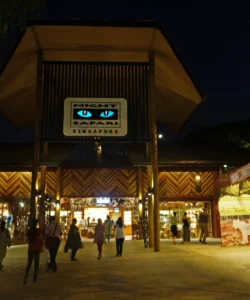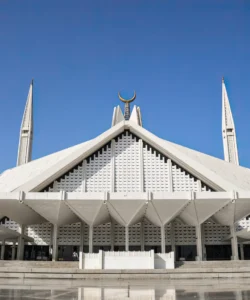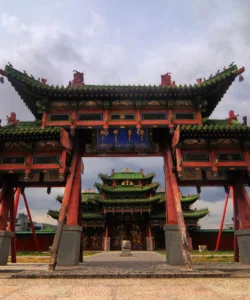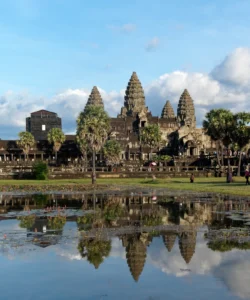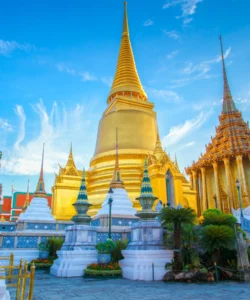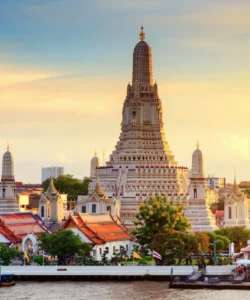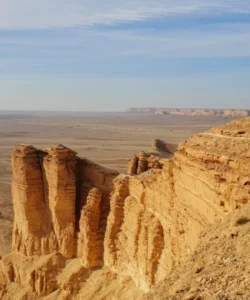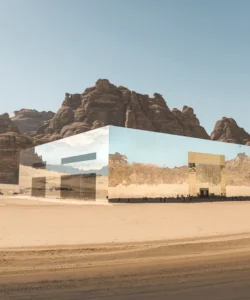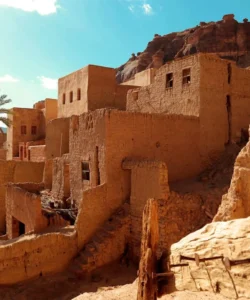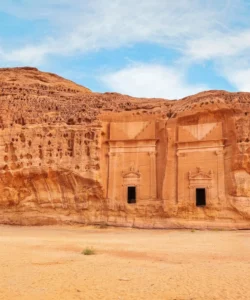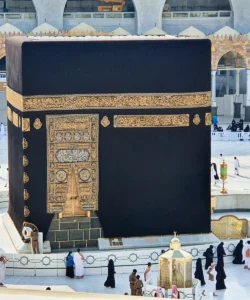Al-Masjid an-Nabawi (Arabic: ٱَلْمَسْجِدُ ٱلنَّبَوِيّ, romanized: al-Masjid an-Nabawī, lit. ‘The Prophet’s Mosque’), often simply called the Prophet’s Mosque, is the second holiest site in Islam, after Al-Masjid Al-Haram in Mecca. Located in the city of Medina, Saudi Arabia, it was originally established and built by Prophet Muhammad himself in 622 CE. It is a place of immense spiritual significance, serving not only as a mosque but also as the final resting place of Prophet Muhammad and two of his closest companions.
Name: Al-Masjid an-Nabawi (The Prophet’s Mosque; also Masjid Nabawi, Masjid al-Nabawi, Al-Haram Al Madani, The Green Dome Mosque)
Address: The mosque is located in the heart of Medina, Al Madinah Province, Saudi Arabia. It stands in what was traditionally the center of Medina, surrounded by many hotels and old markets.
How to Get There:
Access to Al-Masjid an-Nabawi and the city of Medina is permitted only for Muslims. Non-Muslims are generally prohibited from entering the holy city.
- By Air: The closest international airport is Prince Mohammad Bin Abdulaziz International Airport (MED) in Medina. It has direct flights from major cities in Saudi Arabia and various international hubs, particularly for pilgrims. From the airport, a short taxi or bus ride takes you to the mosque (approx. 20-30 minutes).
- By High-Speed Rail: The Haramain High-Speed Railway provides a convenient and fast connection between Medina, Mecca, Jeddah, and King Abdullah Economic City. This is a popular option for pilgrims traveling between the two holy cities.
- By Road: Medina is well-connected by modern highways from all parts of Saudi Arabia.
- Pilgrimage Regulations: During Hajj and Umrah seasons, millions of pilgrims visit Medina after or before performing rituals in Mecca. Special visas (Hajj or Umrah visas) are required.
- Within the Mosque: The mosque is designed for massive pedestrian flow. It has over 40 gates (with major ones like Bab al-Salam, Bab Jibril, Bab Malik Fahd), many equipped with escalators and lifts for accessibility. The vast prayer halls and courtyards are easily navigable on foot.
- Best Time to Visit: The mosque is open 24 hours a day, 7 days a week. The peak times are during the annual Hajj pilgrimage (month of Dhu al-Hijja) and the Umrah pilgrimage (can be performed anytime). These periods see the largest gatherings. Outside of peak pilgrimage times, it’s generally less crowded.
Landscape and Architecture:
Al-Masjid an-Nabawi is a magnificent architectural complex that has undergone extensive renovations and expansions over centuries, seamlessly blending historical elements with modern Islamic aesthetics and technology.
- The Green Dome (Al-Qubbah Al-Khaḍrāʾ): The most iconic and recognizable feature of the mosque is the Green Dome, which stands over the tomb of Prophet Muhammad and the graves of the first two Rashidun caliphs, Abu Bakr and Umar. The dome was first built in 1279 CE and first painted green in 1837 CE, becoming a powerful symbol of Medina.
- Rawdah (Ar-Rawdah ash-Sharifah): This highly revered area, known as “The Purified Garden,” is a specific section between Prophet Muhammad’s tomb (originally his house) and his original pulpit (minbar). It is marked by green carpets and is considered a garden from Paradise. Pilgrims strive to pray in this sacred space, though it is usually very crowded.
- Minarets: The mosque is adorned with ten towering minarets, each approximately 104-105 meters (341 feet) high. These minarets, added during various expansions, are equipped with modern lighting systems, creating a mesmerizing view, especially at night.
- Vast Capacity: The modern structure of the mosque is expansive, covering 82,000 square meters (over 880,000 sq ft) of ground. It can accommodate over half a million worshippers in its main halls and over a million worshippers when including its courtyards and surrounding paved areas (especially during Hajj and Umrah seasons), making it the second largest mosque in the world by capacity.
- Sliding Domes and Retractable Umbrellas: A marvel of modern architecture, the flat paved roof of the mosque is topped with 27 large sliding domes on square bases. These domes can slide out on metal tracks to shade areas of the roof and create light wells for the prayer hall, enhancing ventilation and natural light. Similarly, the vast courtyards are shaded by giant, foldable, umbrella-like canopies that open and close based on weather conditions. This innovative design was conceived by German architect Mahmoud Bodo Rasch.
- Luxurious Materials and Advanced Systems: The mosque is constructed using high-quality marble (white and polychrome), stones, and features intricately designed marble columns, archways, and ceilings with ornate patterns and calligraphy. Advanced climate control systems, including ventilation grills in column pedestals, ensure a comfortable environment for millions of visitors.
- Historical Sections: The oldest part of the mosque, the Ottoman prayer hall, dates back to the mid-19th century and is characterized by its colorful decorations and numerous small pillars, contrasting with the gleaming white marble of the newer Saudi expansions.
- Jannatul Baqi Cemetery: Located adjacent to the mosque on its eastern side, this historic cemetery is the resting place of many of Prophet Muhammad’s companions, family members, and revered Islamic figures. It is a significant site for pilgrims.
- Mihrab and Minbar: The mosque contains several Mihrabs (prayer niches) and Minbars (pulpits), marking various historical prayer spots and sermon delivery locations by the Prophet and later caliphs.
What Makes It Famous:
- Second Holiest Site in Islam: After Al-Masjid Al-Haram in Mecca, Al-Masjid an-Nabawi is the second most sacred site in Islam, holding immense spiritual importance for Muslims worldwide.
- Prophet Muhammad’s Burial Place: It is the final resting place of Prophet Muhammad, his tomb being located directly under the Green Dome. This makes it an unparalleled pilgrimage destination for Muslims. The graves of the first two caliphs, Abu Bakr and Umar, are also within the mosque.
- Built by Prophet Muhammad: The mosque was originally established and built by Prophet Muhammad himself in 622 CE upon his arrival in Medina (then Yathrib). This direct connection to the Prophet makes its foundation profoundly significant.
- Historical and Community Hub: In its early days, the mosque served as the central hub of the early Islamic community, functioning not just as a place of prayer but also as a community center, court of law, school, and social services center.
- The Green Dome: The iconic Green Dome over the Prophet’s tomb is a universally recognized symbol of Medina and one of the most photographed features of the mosque.
- Modern Architectural Innovation: The massive Saudi expansions of the 1990s introduced groundbreaking architectural features like the sliding domes and retractable umbrella canopies, which are marvels of modern engineering designed for immense crowd comfort and efficiency.
- Spiritual Oasis for Pilgrims: Millions of pilgrims who perform Hajj or Umrah extend their journey to Medina to visit the Prophet’s Mosque, seeking blessings and spiritual solace in this revered space.
- Jannatul Baqi Cemetery: The adjacent cemetery is a significant historical and spiritual site, holding the graves of numerous companions and family members of the Prophet.
Differences from Some Other Wonders:
- Prophet’s Burial Place: While Al-Masjid Al-Haram in Mecca is the absolute holiest site due to the Kaaba and its role as the Qiblah, Al-Masjid an-Nabawi holds unique significance as the burial place of Prophet Muhammad himself. This personal connection to the founder of Islam sets it apart.
- Green Dome vs. Kaaba: While Al-Masjid Al-Haram features the simple, cubic Kaaba as its center, Al-Masjid an-Nabawi is famously recognized by its Green Dome, which covers the Prophet’s tomb. This iconic visual identifier is unique to Medina.
- Sliding Domes and Retractable Umbrellas: The innovative architectural technology of its massive sliding domes and giant retractable umbrellas in its courtyards are distinctive features designed to manage comfort for millions of worshippers in the hot climate, a level of adaptive engineering not found in older mosques or Al-Masjid Al-Haram’s open courtyard.
- Historical Evolution of Mosque Design: The mosque’s long history of continuous expansion by successive Islamic empires (Umayyad, Abbasid, Mamluk, Ottoman, Saudi) makes it a living architectural record, showcasing the evolution of Islamic mosque design over nearly 1400 years, from simple mud-brick to modern grandeur.
- Less Focus on Ritual Circumambulation (Tawaf): While pilgrims pray and visit, the central ritual of Tawaf (circumambulation) around a specific structure is exclusive to the Kaaba in Mecca. Here, the focus is on prayer, visitation (Ziyarah), and reverence for the Prophet’s resting place.
- Urban Integration: The mosque is deeply integrated into the city center of Medina, with its vast courtyards often feeling like extensions of the urban fabric, and surrounded by hotels and markets, offering a distinct experience from the more exclusive, isolated nature of Al-Masjid Al-Haram.
Al-Masjid an-Nabawi Photos:

































